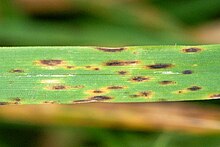| Cochliobolus sativus | |
|---|---|

| |
| Symptoms on a wheat leaf | |
| Scientific classification | |
| Domain: | Eukaryota |
| Kingdom: | Fungi |
| Division: | Ascomycota |
| Class: | Dothideomycetes |
| Order: | Pleosporales |
| Family: | Pleosporaceae |
| Genus: | Cochliobolus |
| Species: | C. sativus
|
| Binomial name | |
| Cochliobolus sativus (S. Ito & Kurib.) Drechsler ex Dastur (1942)
| |
| Synonyms | |
|
Bipolaris californica (Mackie & G.E. Paxton) Gornostaĭ (1978) | |
The fungus Cochliobolus sativus is the teleomorph (sexual stage) of Bipolaris sorokiniana (anamorph) which is the causal agent of a wide variety of cereal diseases. The pathogen can infect and cause disease on roots (where it is known as common root rot), leaf and stem, and head tissue. C. sativus is extremely rare in nature and thus it is the asexual or anamorphic stage which causes infections. The two most common diseases caused by B. sorokiniana are spot blotch and common root rot, mainly on wheat and barley crops.